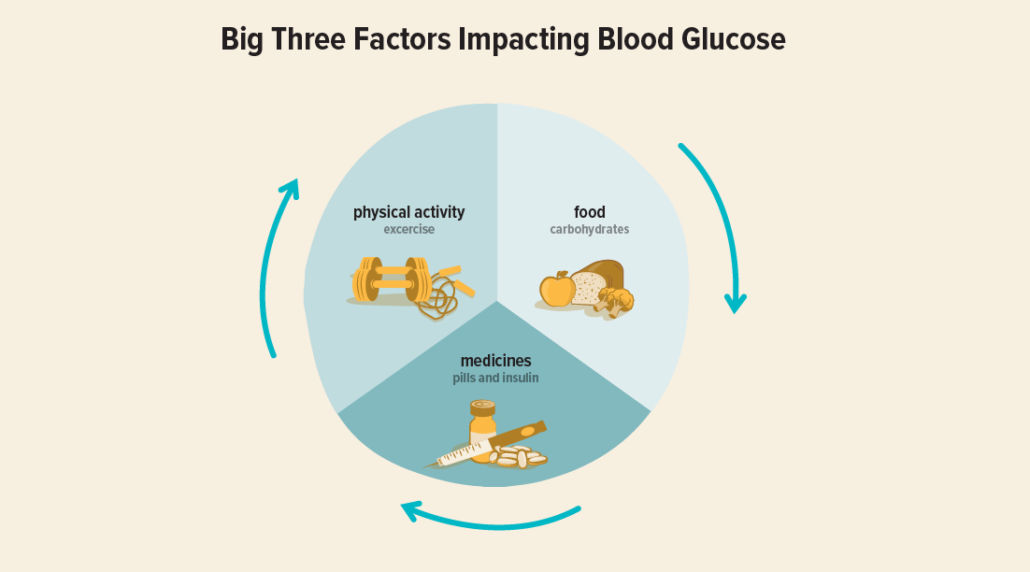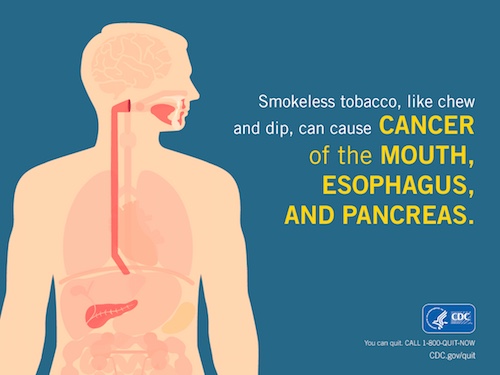Manage Blood Sugar
It’s important to keep your blood sugar levels in your target range as much as possible to help prevent or delay long-term, serious health problems, such as heart disease, vision loss, and kidney disease. Staying in your target range can also help improve your energy and mood. Find answers below to common questions about blood sugar for people with diabetes.
Use a blood sugar meter (also called a glucometer) or a continuous glucose monitor (CGM) to check your blood sugar. A blood sugar meter measures the amount of sugar in a small sample of blood, usually from your fingertip. A CGM uses a sensor inserted under the skin to measure your blood sugar every few minutes. If you use a CGM, you’ll still need to test daily with a blood sugar meter to make sure your CGM readings are accurate.
When should I check my blood sugar?
How often you check your blood sugar depends on the type of diabetes you have and if you take any diabetes medicines.
Typical times to check your blood sugar include:
- When you first wake up, before you eat or drink anything.
- Before a meal.
- Two hours after a meal.
- At bedtime.
If you have type 1 diabetes, have type 2 diabetes and take insulin, or often have low blood sugar, your doctor may want you to check your blood sugar more often, such as before and after you’re physically active.
What are blood sugar targets?
A blood sugar target is the range you try to reach as much as possible. These are typical targets:
- Before a meal: 80 to 130 mg/dL.
- Two hours after the start of a meal: Less than 180 mg/dL.
Your blood sugar targets may be different depending on your age, any additional health problems you have, and other factors. Be sure to talk to your health care team about which targets are best for you.
What causes low blood sugar?
Low blood sugar (also called hypoglycemia) has many causes, including missing a meal, taking too much insulin, taking other diabetes medicines, exercising more than normal, and drinking alcohol. Blood sugar below 70 mg/dL is considered low.
Signs of low blood sugar are different for everyone. Common symptoms include:
- Shaking.
- Sweating.
- Nervousness or anxiety.
- Irritability or confusion.
- Dizziness.
- Hunger.
Know what your individual symptoms are so you can catch low blood sugar early and treat it. If you think you may have low blood sugar, check it even if you don’t have symptoms. Low blood sugar can be dangerous and should be treated as soon as possible.
How can I treat low blood sugar?
If you’ve had low blood sugar without feeling or noticing symptoms (hypoglycemia unawareness), you may need to check your blood sugar more often to see if it’s low and treat it. Driving with low blood sugar can be dangerous, so be sure to check your blood sugar before you get behind the wheel.
Carry supplies for treating low blood sugar with you. If you feel shaky, sweaty, or very hungry or have other symptoms, check your blood sugar. Even if you don’t have symptoms but think you may have low blood sugar, check it. If your blood sugar is lower than 70 mg/dL, do one of the following immediately:
- Take four glucose tablets.
- Drink four ounces of fruit juice.
- Drink four ounces of regular soda, not diet soda.
- Eat four pieces of hard candy.
Wait for 15 minutes and then check your blood sugar again. Do one of the above treatments again until your blood sugar is 70 mg/dL or above and eat a snack if your next meal is an hour or more away. If you have problems with low blood sugar, ask your doctor if your treatment plan needs to be changed.
What causes blood sugar to be high?
Many things can cause high blood sugar (hyperglycemia), including being sick, being stressed, eating more than planned, and not giving yourself enough insulin. Over time, high blood sugar can lead to long-term, serious health problems. Symptoms of high blood sugar include:
- Feeling very tired.
- Feeing thirsty.
- Having blurry vision.
- Needing to urinate (pee) more often.
If you get sick, your blood sugar can be hard to manage. You may not be able to eat or drink as much as usual, which can affect blood sugar levels. If you’re ill and your blood sugar is 240 mg/dL or above, use an over-the-counter ketone test kit to check your urine for ketones and call your doctor if your ketones are high. High ketones can be an early sign of diabetic ketoacidosis, which is a medical emergency and needs to be treated immediately.
What are ketones?
Ketones are a kind of fuel produced when fat is broken down for energy. Your liver starts breaking down fat when there’s not enough insulin in your bloodstream to let blood sugar into your cells.
What is diabetic ketoacidosis?
If you think you may have low blood sugar, check it even if you don’t have symptoms.
When too many ketones are produced too fast, they can build up in your body and cause diabetic ketoacidosis, or DKA. DKA is very serious and can cause a coma or even death. Common symptoms of DKA include:
- Fast, deep breathing.
- Dry skin and mouth.
- Flushed face.
- Frequent urination or thirst that lasts for a day or more.
- Fruity-smelling breath.
- Headache.
- Muscle stiffness or aches.
- Nausea and vomiting.
- Stomach pain.
If you think you may have DKA, test your urine for ketones. Follow the test kit directions, checking the color of the test strip against the color chart in the kit to see your ketone level. If your ketones are high, call your health care provider right away. DKA requires treatment in a hospital.
DKA happens most in people with type 1 diabetes and is sometimes the first sign of type 1 in people who haven’t yet been diagnosed. People with type 2 diabetes can also develop DKA, but it’s less common.
How can I treat high blood sugar?
Talk to your doctor about how to keep your blood sugar levels within your target range. Your doctor may suggest the following:
- Be more active. Regular exercise can help keep your blood sugar levels on track. Important: don’t exercise if ketones are present in your urine. This can make your blood sugar go even higher.
- Take medicine as instructed. If your blood sugar is often high, your doctor may change how much medicine you take or when you take it.
- Follow your diabetes meal plan. Ask your doctor or dietitian for help if you’re having trouble sticking to it.
- Check your blood sugar as directed by your doctor. Check more often if you’re sick or if you’re concerned about high or low blood sugar.
- Talk to your doctor about adjusting how much insulin you take and what types of insulin (such as short-acting) to use.
How do carbs affect blood sugar?
Carbs in food make your blood sugar levels go higher after you eat them than when you eat proteins or fats. You can still eat carbs if you have diabetes. The amount you can have and stay in your target blood sugar range depends on your age, weight, activity level, and other factors. Counting carbs in foods and drinks is an important tool for managing blood sugar levels. Make sure to talk to your health care team about the best carb goals for you.
What is the A1C test?
The A1C test is a simple blood test that measures your average blood sugar levels over the past 2 or 3 months. The test is done at a lab or your doctor’s office in addition to—not instead of—regular blood sugar testing you do yourself.
A1C testing is part of the ABCs of diabetes—important steps you can take to prevent or delay health complications down the road:
- A: Get a regular A1C test.
- B: Try to keep your blood pressure below 140/90 mm Hg (or the target your doctor sets).
- C: Manage your cholesterol levels.
- s: Stop smoking or don’t start.
The A1C goal for most adults with diabetes is between 7% and 8%, but your goal may be different depending on your age, other health conditions, medicines you’re taking, and other factors. Work with your doctor to establish a personal A1C goal for you.
What else can I do to help manage my blood sugar levels?
Eating a healthy diet with plenty of fruit and vegetables, maintaining a healthy weight, and getting regular physical activity can all help. Other tips include:
- Keep track of your blood sugar levels to see what makes them go up or down.
- Eat at regular times, and don’t skip meals.
- Choose foods lower in calories, saturated fat, trans fat, sugar, and salt.
- Track your food, drink, and physical activity.
- Drink water instead of juice or soda.
- Limit alcoholic drinks.
- For a sweet treat, choose fruit.
- Control your food portions (for example, use the plate method: fill half your plate with non-starchy vegetables, a quarter with lean protein, and a quarter with a grain or starchy food).
How can I pay for tests and diabetes supplies?
Medicare, Medicaid, and most private insurance plans pay for the A1C test and fasting blood sugar test as well as some diabetes supplies. Check your plan or ask your health care team for help finding low-cost or free supplies, and see How to Save Money on Diabetes Care for more resources.




